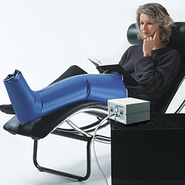Apparative Compression
A method of compression therapy
Besides compression stockings and compression bandages, there is a third form of compression therapy: Apparative intermittent compression (AIC) or intermittent pneumatic compression (IPC). In addition to decongestive therapy for vein and lymphological diseases or to stimulate arterial circulation, intermittent compression (IC) is also used to prevent thrombosis.
In the case of intermittent compression (IC), the legs or arms are covered by two-layered leg, arm or trouser cuffs, or a kind of air cushion. A compressor regulates the air pressure in the chambers of the cuff and thus determines the strength of the compression on the extremities. Depending on the design, different levels of pressure can be achieved – such as the pressure of compression class I to IV and higher.
Mechanical inflating and deflating
Depending on whether it is used for thrombosis prevention or as part of decongestion therapy, different types of systems are used: There are cuffs with one or more air chambers. The devices have a maximum of 12 air chambers. The single-chamber system can only be used intermittently, i.e. pressure is added and applied alternately. With the multi-chamber cuff, the individually determined pressure required in the individual chambers can vary and be built up and released at specific intervals. In addition, the devices differ in terms of how the air chambers are arranged and in which cycles pressure is generated or released.
This inflating and deflating imitates the muscle activity when moving and supports the mechanism of our muscle pump. The muscle pump ensures that the blood is transported to the heart against the force of gravity and also promotes lymph drainage. This makes intermittent compression (IC) also suitable for immobile patients. As a result, the devices are prescribed by doctors for outpatient use as home devices and can also be used in hospitals and surgeries.

